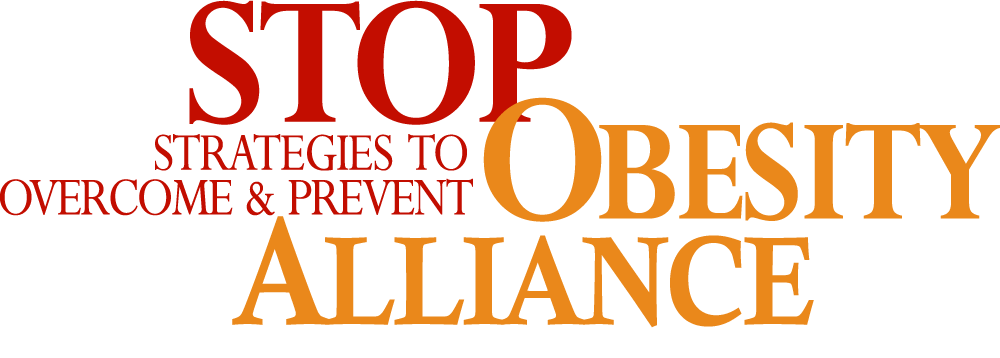Washington, D.C. – The information gap and general lack of understanding of obesity’s unique and disproportionate impact on women contributes to the challenges of the 65 million American women who are considered overweight or obese, said the Strategies to Overcome and Prevent (STOP) Obesity Alliance Task Force on Women at a meeting on Capitol Hill today. Through discussions with health experts and an extensive review of obesity prevalence research, the Task Force found women to be hit hardest by obesity – confounding efforts to turn the tide on the nation’s obesity problem, especially in children.
“We rely on women to serve as the ‘Chief Health Officer’ for the family, but with more than a third being obese themselves, we’re unlikely to break the cycle with children without finding ways for moms to overcome their weight problems as well,” said Christine Ferguson, professor at The George Washington University and Director of the STOP Obesity Alliance. “What’s more, achieving healthier weights for women, whether they are mothers or not, will mean a healthier society overall. Unfortunately, significant barriers stand in the way.”
Ferguson was joined by Khaliah Ali, editor-in-chief of WLS Lifestyles magazine, president of My Program for Life and daughter of boxing legend Muhammad Ali, as well as representatives from the American Association of Diabetes Educators, Black Women’s Health Imperative, National Council of La Raza’s Institute on Hispanic Health, WomenHeart: The National Coalition for Women with Heart Disease and others to reveal the Task Force on Women’s assessment of the key barriers blocking progress. Overcoming them, they said, could help women fight the extra pounds that can lead to serious chronic diseases like diabetes and heart disease.
The STOP Obesity Alliance Task Force on Women identified the following four areas that have a significant impact on weight and obesity in women:
- The physiological, psychological, cultural and socioeconomic factors of obesity that disproportionately affect women as well as the unique impact of overweight and obesity in women at various points in their lives, including but not limited to puberty, pregnancy and menopause.
- Pervasive racial and ethnic disparities in obesity prevalence and health outcomes among minority women, particularly African-American, Hispanic and Native American women.
- Systemic, gender-based biases portrayed in the media and encountered in educational, workplace, social and health care environments, including a focus on redefining and maintaining healthy weight goals based on health rather than societal norms or unrealistic body image ideals.
- Expectations for women as caretakers and the role they play in influencing and shaping the health behaviors and decisions of their families, especially their children.
The Alliance’s Task Force on Women includes nearly 20 influential health advocacy organizations and aims to promote discussion among decision makers to look at strategies that will improve the health of overweight and obese American women and their families. The Task Force, a sub-group of the Alliance’s membership of more than 40 consumer, medical, government, labor, business, insurance and quality-of-care organizations, includes the following groups: American Association of Diabetes Educators, American College of Sports Medicine, American Diabetes Association, America’s Health Insurance Plans, American Heart Association, American Medical Women’s Association, American Sleep Apnea Association, Binge Eating Disorder Association, Black Women’s Health Imperative, Canyon Ranch Institute, HealthyWomen, National Association of Social Workers, National Black Nurses Association, National Council of La Raza, National Indian Health Board, Society for Women’s Health Research and WomenHeart: The National Coalition for Women with Heart Disease.
“This is the first step down an important path – a path that we hope will reap significant and immediate benefits in reducing the risks and consequences of obesity for women and their families,” said Ferguson.
About Overweight and Obesity in Women
Rising obesity rates across the nation have led to worsening health outcomes and increasing inequities in health [1] – 72 million American adults are now considered obese[2] and more than one-third of women are obese. There are large racial and ethnic disparities in the prevalence of obesity among women, with Black and Hispanic women much more likely to be obese than White women. In 2007-08, nearly 50 percent of non-Hispanic black women and 43 percent of Hispanic women over the age of 20 were obese, compared to 33 percent of non-Hispanic white women.[3] Additionally, economists have identified obesity as a major driver of health care utilization and spending and a contributor to escalating health care costs. In fact, a recent study published in the journal Health Affairs found that obesity accounts for 9.1 percent of annual health care spending in the United States – nearly $147 billion dollars a year.[4]
[1] Trust for America’s Health. (2009). F as in fat: how obesity policies are failing America. Washington, D.C.: Jeffrey Levi et al.
[2] Ogden C.L., Carroll M.D., McDowell M.A., Flegal K.M. (2007). Obesity among adults in the United States— no change since 2003–2004. NCHS data brief no 1. Hyattsville, MD: National Center for Health Statistics.
[3] Flegal K.M., Carroll M.D., Ogden C.L., Curtin L.R. (2010). Prevalence and trends in obesity among US adults, 1999-2008. JAMA, 303, 235-241.
[4] Finkelstein E.A., Trogdon J.G., Cohen J.W., Dietz W. (2009) Annual medical spending attributable to obesity: payer- and service-specific estimates. Health Affairs, 28, w822-w831.

